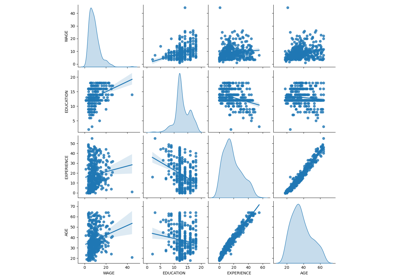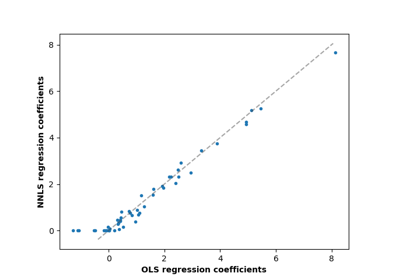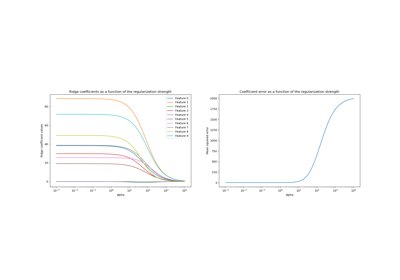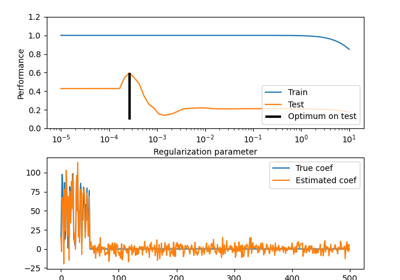注意
转到末尾以下载完整示例代码,或通过 JupyterLite 或 Binder 在浏览器中运行此示例。
机器学习无法推断因果效应#
机器学习模型非常适合衡量统计关联。不幸的是,除非我们愿意对数据做出强假设,否则这些模型无法推断因果效应。
为了说明这一点,我们将模拟一种情况,试图回答教育经济学中最重要的问题之一:获得大学学位对每小时工资的因果效应是什么? 尽管这个问题的答案对政策制定者至关重要,但遗漏变量偏差(OVB)使我们无法识别这种因果效应。
# Authors: The scikit-learn developers
# SPDX-License-Identifier: BSD-3-Clause
数据集:模拟的每小时工资#
数据生成过程如下面的代码所示。工作经验年限和能力衡量指标取自正态分布;父母一方的每小时工资取自 Beta 分布。然后我们创建一个大学学位指标,它受到能力和父母每小时工资的正向影响。最后,我们将每小时工资建模为所有先前变量和一个随机分量的线性函数。请注意,所有变量都对每小时工资有正向影响。
import numpy as np
import pandas as pd
n_samples = 10_000
rng = np.random.RandomState(32)
experiences = rng.normal(20, 10, size=n_samples).astype(int)
experiences[experiences < 0] = 0
abilities = rng.normal(0, 0.15, size=n_samples)
parent_hourly_wages = 50 * rng.beta(2, 8, size=n_samples)
parent_hourly_wages[parent_hourly_wages < 0] = 0
college_degrees = (
9 * abilities + 0.02 * parent_hourly_wages + rng.randn(n_samples) > 0.7
).astype(int)
true_coef = pd.Series(
{
"college degree": 2.0,
"ability": 5.0,
"experience": 0.2,
"parent hourly wage": 1.0,
}
)
hourly_wages = (
true_coef["experience"] * experiences
+ true_coef["parent hourly wage"] * parent_hourly_wages
+ true_coef["college degree"] * college_degrees
+ true_coef["ability"] * abilities
+ rng.normal(0, 1, size=n_samples)
)
hourly_wages[hourly_wages < 0] = 0
模拟数据描述#
下面的图表显示了每个变量的分布以及成对散点图。我们 OVB 故事的关键是能力和大学学位之间的正向关系。
import seaborn as sns
df = pd.DataFrame(
{
"college degree": college_degrees,
"ability": abilities,
"hourly wage": hourly_wages,
"experience": experiences,
"parent hourly wage": parent_hourly_wages,
}
)
grid = sns.pairplot(df, diag_kind="kde", corner=True)
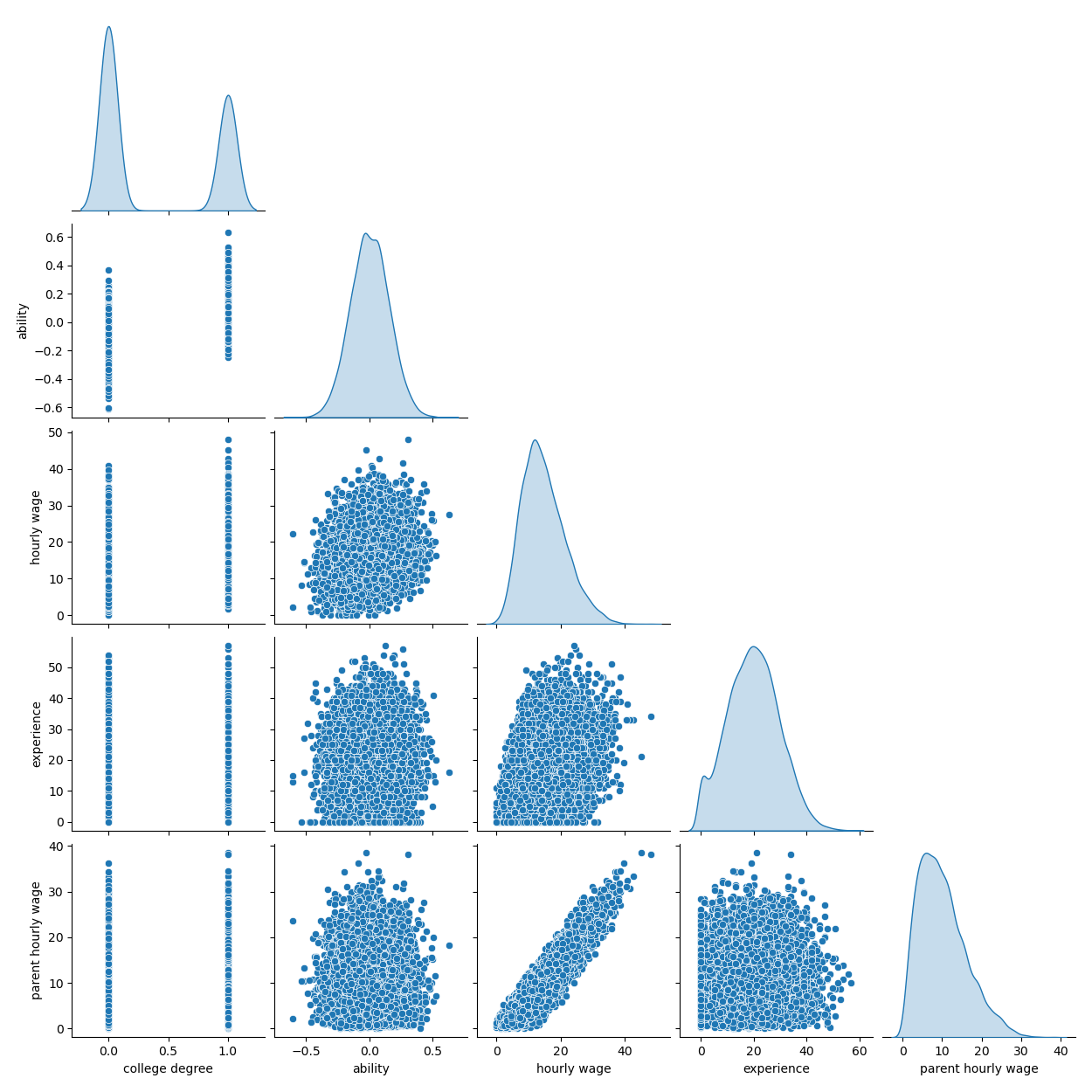
在下一节中,我们训练预测模型,因此我们将目标列与特征分开,并将数据分成训练集和测试集。
from sklearn.model_selection import train_test_split
target_name = "hourly wage"
X, y = df.drop(columns=target_name), df[target_name]
X_train, X_test, y_train, y_test = train_test_split(X, y, test_size=0.2, random_state=0)
具有完全观测变量的收入预测#
首先,我们训练一个预测模型,一个 LinearRegression 模型。在这个实验中,我们假设真实生成模型使用的所有变量都可用。
from sklearn.linear_model import LinearRegression
from sklearn.metrics import r2_score
features_names = ["experience", "parent hourly wage", "college degree", "ability"]
regressor_with_ability = LinearRegression()
regressor_with_ability.fit(X_train[features_names], y_train)
y_pred_with_ability = regressor_with_ability.predict(X_test[features_names])
R2_with_ability = r2_score(y_test, y_pred_with_ability)
print(f"R2 score with ability: {R2_with_ability:.3f}")
R2 score with ability: 0.975
如高 R2 分数所示,该模型能很好地预测每小时工资。我们绘制模型系数以显示我们准确地恢复了真实生成模型的值。
import matplotlib.pyplot as plt
model_coef = pd.Series(regressor_with_ability.coef_, index=features_names)
coef = pd.concat(
[true_coef[features_names], model_coef],
keys=["Coefficients of true generative model", "Model coefficients"],
axis=1,
)
ax = coef.plot.barh()
ax.set_xlabel("Coefficient values")
ax.set_title("Coefficients of the linear regression including the ability features")
_ = plt.tight_layout()
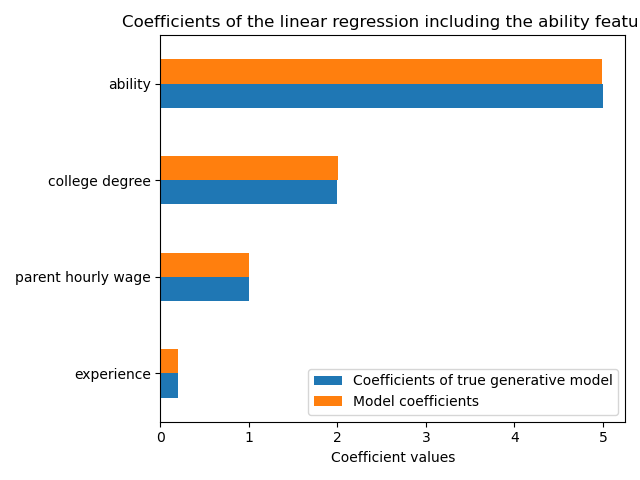
具有部分观测值的收入预测#
在实践中,智力能力没有被观测到,或者只是通过无意中也衡量教育的代理指标(例如智商测试)来估计。但从线性模型中省略“能力”特征会通过正向 OVB 夸大估计值。
features_names = ["experience", "parent hourly wage", "college degree"]
regressor_without_ability = LinearRegression()
regressor_without_ability.fit(X_train[features_names], y_train)
y_pred_without_ability = regressor_without_ability.predict(X_test[features_names])
R2_without_ability = r2_score(y_test, y_pred_without_ability)
print(f"R2 score without ability: {R2_without_ability:.3f}")
R2 score without ability: 0.968
当我们省略能力特征时,模型的预测能力在 R2 分数方面相似。我们现在检查模型的系数是否与真实生成模型不同。
model_coef = pd.Series(regressor_without_ability.coef_, index=features_names)
coef = pd.concat(
[true_coef[features_names], model_coef],
keys=["Coefficients of true generative model", "Model coefficients"],
axis=1,
)
ax = coef.plot.barh()
ax.set_xlabel("Coefficient values")
_ = ax.set_title("Coefficients of the linear regression excluding the ability feature")
plt.tight_layout()
plt.show()
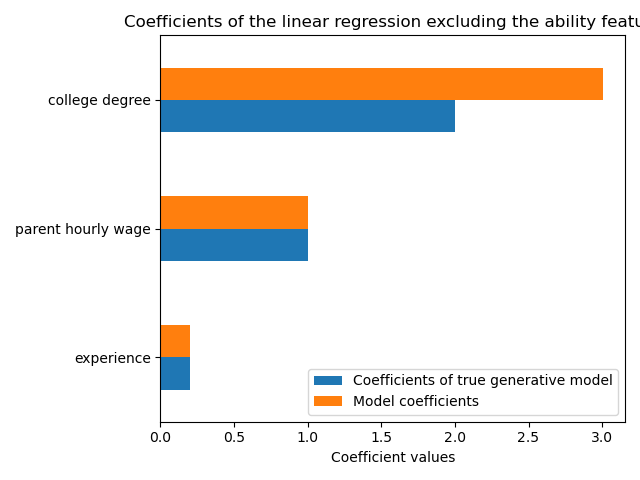
为了弥补遗漏的变量,模型夸大了大学学位特征的系数。因此,将此系数解释为真实生成模型的因果效应是不正确的。
经验教训#
机器学习模型并非为估计因果效应而设计。虽然我们使用线性模型进行了演示,但 OVB 会影响任何类型的模型。
每当解释系数或由某个特征变化引起的预测变化时,重要的是要记住可能存在与相关特征和目标变量都相关的未观测变量。这些变量被称为混杂变量。为了在存在混杂的情况下仍能估计因果效应,研究人员通常会进行实验,其中治疗变量(例如大学学位)是随机化的。当实验成本过高或不道德时,研究人员有时可以使用其他因果推断技术,例如工具变量(IV)估计。
脚本总运行时间: (0 分钟 1.693 秒)
相关示例
